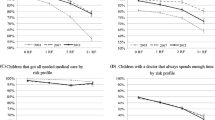Abstract
Objectives Family-centered care has been associated with positive outcomes for children with special health care needs. The purpose of the current study was to examine the relationship of family-centered care as associated with care coordination with schools and school absences (e.g., missed days) as reported by parents of children with special health care needs. Methods The current study utilized data from the National Survey of Children with Special Health Care Needs 2009-201 (N = 40,242) to achieve this purpose. The National Survey of Children with Special Health Care Needs may be considered a nationally-representative and community-based sample of parent responses for children with special health care needs across the United States. Results Results from the current study indicate that family-centered care is associated with fewer absences and improved care coordination with schools when applicable. The variables of functional difficulties, poverty level, and the number of conditions were statistically controlled. Conclusions We suggest that the positive influence of family-centered care when practiced extends beyond the family and interacts with educational outcomes. We also suggest that the role of schools appears to be under-studied given the role that schools can play in family-centered care.

Similar content being viewed by others
References
Barnard-Brak, L., Nuner, J., Sulak, T., & Davis, T. N. (2015). Costs of and satisfaction with child care arrangements for parents of children with emotional or behavioral disorders. Journal of Family Issues, 36(14), 1887–1903.
Child and Adolescent Health Measurement Initiative (CAHMI). (2012). 2009–2010 NS-CSHCN Indicator and Outcome Variables SPSS Codebook, Version 1. Data Resource Center for Child and Adolescent Health, http://www.childhealthdata.org.
Cohen, J. (1988). Statistical power analysis for the social sciences. Hillsdale, NJ: Erlbaum.
Denboba, D., McPherson, M. G., Kenney, M. K., Strickland, B., & Newacheck, P. W. (2006). Achieving family and provider partnerships for children with special health care needs. Pediatrics, 118(4), 1607–1615.
Dempsey, I., & Keen, D. (2008). A review of processes and outcomes in family-centered services for children with a disability. Topics in Early Childhood Special Education, 28(1), 42–52.
Dunst, C. J., Trivette, C. M., & Hamby, D. W. (2007). Meta‐analysis of family‐centered helpgiving practices research. Mental Retardation and Developmental Disabilities Research Reviews, 13(4), 370–378.
Enders, C. K., & Bandalos, D. L. (2001). The relative performance of full information maximum likelihood estimation for missing data in structural equation models. Structural Equation Modeling, 8(3), 430–457.
Engelke, M. K., Guttu, M., Warren, M. B., & Swanson, M. (2008). School nurse case management for children with chronic illness: Health, academic, and quality of life outcomes. The Journal of School Nursing, 24(4), 205–214.
Farmer, J. E., Clark, M. J., Sherman, A., Marien, W. E., & Selva, T. J. (2005). Comprehensive primary care for children with special health care needs in rural areas. Pediatrics, 116(3), 649–656.
Hahs-Vaughn, D. L. (2005). A primer for using and understanding weights with national data sets. The Journal of Experimental Education, 73(3), 221–248.
Hahs-Vaughn, D. L. (2006). Analysis of data from complex samples. International Journal of Research & Method in Education, 29(2), 165–183.
Institute of Patient- and Family-Centered Care (IPFCC) (2010). What is patient- and family-centered health care? Bethesda, MD: Institute for Patient- and Family-Centered Care.
Kuhlthau, K., Bloom, S., Van Cleave, J., Knapp, A., Romm, D., Klatka, K., Homer, C. J., Newacheck, P. W., & Perrin, J. M. (2011). Evidence of family-centered care for children with special health care needs: A systematic review. Academic Pediatrics, 11(2), 136–143.
Kuo, D. Z., Bird, T. M., & Tilford, J. M. (2011). Associations of family-centered care with health care outcomes for children with special health care needs. Maternal Child Health Journal, 15(6), 794–805.
Mangione-Smith, R., Schonlau, M., Chan, K. S., Keesey, J., Rosen, M., Louis, T. A., & Keeler, E. (2005). Measuring the effectiveness of a collaborative for quality improvement in pediatric asthma care: Does implementing the chronic care model improve processes and outcomes of care? Ambulatory Pediatrics, 5, 75–82.
Mukherjee, S., Lightfoot, J., & Sloper, P. (2002). Communicating about pupils in mainstream school with special health needs. Child: Care, Health, and Development, 28(1), 21–27.
Muthén, L. K., & Muthén, B. O. (2013). MPlus User’s Guide. Los Angeles, CA: Muthén & Muthén.
National Center for Education Statistics (2014). The condition of education. Retrieved from http://nces.ed.gov/programs/coe/indicator_cgg.asp.
Nolan, K. W., Orlando, M., & Liptak, G. S. (2007). Care coordination services for children with special health care needs: Are we family-centered yet? Families, Systems, & Health, 25(3), 293–306.
Palfrey, J. S., Sofis, L. A., Davidson, E. J., Liu, J., Freeman, L., & Ganz, M. L. (2004). The pediatric alliance for coordinated care: Evaluation of a medical home model. Pediatrics, 113, 1507–1516.
Salmon, G., & Kirby, A. (2008). Schools: Central to providing comprehensive CAMH services in the future? Child & Adolescent Mental Health, 13(3), 107–114.
Sheetz, A. H. (2003). Developing school health services in Massachusetts: A public health model. The Journal of School Nursing, 19(4), 204–211.
Stille, C. J., & Antonelli, R. C. (2004). Coordination of care for children with special health care needs. Current Opinion in Pediatrics, 16, 700–705.
Toomey, S. L., Chien, A. T., Elliott, M. N., Ratner, J., & Schuster, M. A. (2013). Disparities in unmet need for care coordination: The National Survey of Children’s Health. Pediatrics, 131(2), 217–224.
Woodside, J. M., Rosenbaum, P. L., King, S. M., & King, G. A. (2001). Family-centered service: Developing and validating a self-assessment tool for pediatric service providers. Children's Health Care, 30(3), 237–252.
Author information
Authors and Affiliations
Corresponding author
Rights and permissions
About this article
Cite this article
Barnard-Brak, L., Stevens, T. & Carpenter, J. Care Coordination with Schools: The Role of Family-Centered Care for Children with Special Health Care Needs. Matern Child Health J 21, 1073–1078 (2017). https://doi.org/10.1007/s10995-016-2203-x
Published:
Issue Date:
DOI: https://doi.org/10.1007/s10995-016-2203-x




